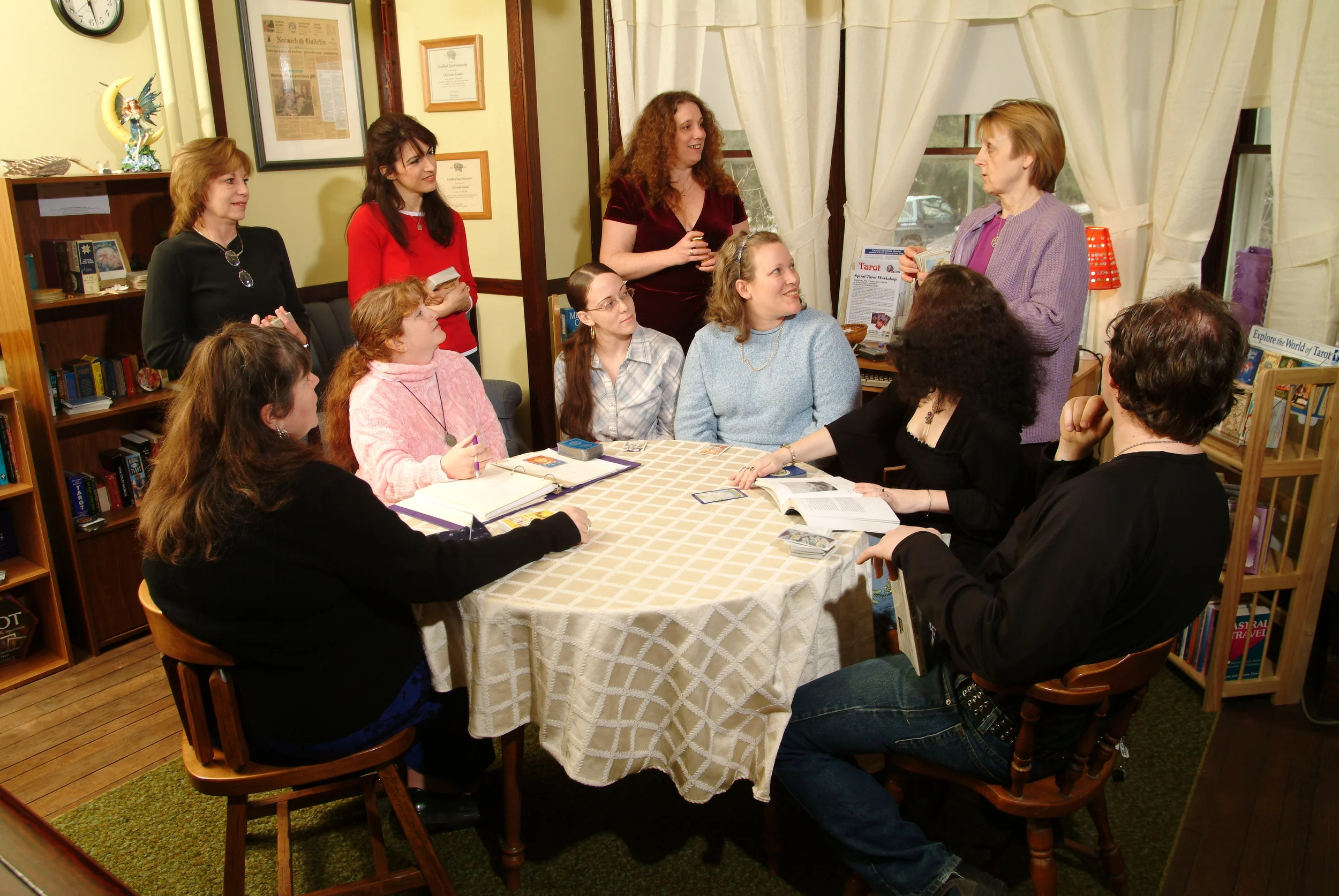
Welcome to my personal blog.
Here you will find my musings, thoughts and observations, all inspired by my experiences as a full-time professional tarot reader.
Internet Tarot Teaching: Let the Buyer Beware
Students are learning tarot in an internet environment where they can access the greatest tarot minds, and, where anyone with a tarot deck and a computer can start an international tarot teaching business. It's up to the student to discover the differences.
"At the Fortune Teller's" by Alma Erdmann, 1900, Public Domain via Wikimedia Commons
The internet is one of the best things and one of the worst things that could have happened to professional tarot.
When my generation of readers was coming up, those of us without a family tradition of tarot reading learned our trade in shops, adult education classes, and from tattered well-loved books by Eden Grey, Mary Greer, Rachel Pollack and their few contemporaries.
While modern tarot students have a wealth of free YouTube videos from which to learn, I had a single shaky VHS tape rented from my local New Age shop.
Even more important than the wealth of information now available to us is our ability to know each other as a community with common interests and goals. By comparison, my generation grew up in a veritable vacuum.
When I speak of "generations" of tarot readers, I'm referring to decades, not age. People begin their tarot journeys at different times of life, so members of a new generation of readers will vary in chronological age.
Our current generation's ability to use the internet to have face-to-face conversations with people all over the world, and to get the word out about our services, has redefined the possibilities for professional tarot reading and teaching.
On the other hand, that the internet has become the center of our education, business development, marketing and peer socializing does create an interesting secondary effect, which is this. Any bozo with a tarot deck, some graphic skills and a computer can start an international tarot business.
That, in and of itself, is not necessary a bad thing. I truly believe that the more people who have tarot in the lives, the better the planet will be. My concern is that there is no distinction made between a tarot “expert” who has done a few email readings and built a great website, and a tarot professional who has been actively giving live, real-time tarot readings for decades. If the person who has been sweating it out in the tarot trenches isn’t very tech savvy, or doesn’t have time to develop an online presence or become a prolific tarot author, a new tarot student might think expensive classes with the shiny website owner would be a better deal than a class with a true tarot veteran. Likewise, the busy tarot reader (who is busy because of their actual tarot reading skill) may not have as much time to devote to marketing their classes, as does the teacher with a smaller client base.
That’s not to say that tarot education, where ever it comes from, is ever a bad idea. The more options we have to learn, the better. It is possible to have the seed of good learning planted by a deficient teacher, if the student ground is fertile enough.
However, it is important to recognize this fact. The names you see the most online may or may not be the most talented, the most experienced, the most ethical, or the most helpful. The names you see the most may the people who are best at marketing, not necessary best at tarot.
The fact is, busy tarot readers are busy giving readings most of the time. De facto, that means that often the most prolific tarot writers and teachers are able to be that prolific because they are not busy doing readings. Often, they base their work on an academic understanding of tarot, rather than an operational understanding of tarot.
Sometimes, teachers and small publishers feed into this loop by encouraging students to go pro long before they are ready. I once worked with a small publisher (now unsurprisingly out of business) who thought it would be great to have a brand-new tarot beginner write a tarot guidebook for beginners. I know that when I am ready to learn something, the person I want to learn it from is certainly not the person who themselves learned it five minutes ago.
Another problem is that a surprising number of teachers share obviously faulty information. In fifteen minutes this morning, I found the following two heinous bloopers in my Facebook feed, from two different tarot teachers. I researched each one to make sure they weren’t simple typos. The fact was, in both cases the teachers had systematically repeated the error, to the point it is clear they are just misinformed, and spreading misinformation.
1. A tarot teacher wanted her students to bring their “Ryder” deck to class. A look at the teacher’s website showed me that this teacher had been using the “Ryder” deck for some time. For the uniformed, there is no “Ryder” deck. “Rider” was an early publisher of the Waite-Smith Tarot. For years, the Waite-Smith tarot was referred to as the “Rider” deck, but never the “Ryder” deck, because that is not (and never was) its name. Today, we call this deck the Waite-Smith, or the RWS (Rider-Waite-Smith).
2. A tarot teacher made a series of videos to help students learn the “tarot suites.” I wish I could have a tarot suite – that is, a block of hotel rooms filled with all things tarot. I think this teacher meant to teach us about the “tarot suits.”
When we don’t take the time to learn the very basic nomenclature of our trade, and then position ourselves as teachers of others, we lower the overall standard of our craft.
If you want to teach tarot, that’s great. Please, learn the basic history and standard terms. If there is controversy, as in, for instance, the pronunciation of the word “tarot,” learn both ways so your students can choose for themselves. And, please, get some actual experience conducting tarot readings. Lose your voice doing readings at a loud party. Sit in the corral at a busy psychic fair and work the cattle call. Read at an outside event in inclement weather. If you can give great readings under these conditions, you can give great readings anywhere, and perhaps teach others to do so as well. Paying your dues as a reader is the only way to be a better reader, and a better teacher. There is no shortcut, no matter what you might hear on the internet.
If you are a new tarot student, you best goal might be to have a number of teachers, rather than just one. Don’t be impressed by internet bling unless you are looking for a web designer. Pay attention to the content of the website to decide if you resonate with your potential teacher’s voice and message.
When you chose a teacher, you have a right to know their level of experience, and the type of venue reading experience they have. Ten thousand email readings do not equal ten thousand real-time readings. If you want to be able to give great readings at parties, expos and fairs, for instance, find a teacher who has made a career doing those kinds of readings.
We are a self-regulated industry, and the buyer must beware. Overall, the amount of brainpower, intuition, integrity and dedication that exists in our community is staggering.
At the same time, as with any other profession, there can also be laziness, chicanery, stupidity, greed and ego at play. Sometimes the poorly educated and the poorly intentioned position themselves to appear to be greatest experts available.
It’s up to the wise seeker to find the differences.
Significators – A Tarot Game
In a local Tarot Circle meeting this past week we played a fun tarot game.
Everyone is welcome at Tarot Circle. Some people have never held a tarot deck before, some people are professional readers. The challenge for me is to devise tarot exercises that are interesting, empowering and doable for the entire group.
I like to begin each meeting with introductions. For this meeting I decided to let the cards introduce us. I asked each person to think about themselves at this moment and pull one card. That card would say something about them, and they would use that to introduce themselves to the group. Then the group would have an opportunity to add interpretations for the card, deepening each person’s understanding of the card they drew and deepening our understanding of each other.
What I wasn’t quite prepared for was how much laughter ensued. Along with the laughter was support, empathy and a few aha moments.
The task was simple, really. Even without knowing the cards, tarot newbies were asked to look at the picture and see themselves within it somehow.
At the end of the exercise folks had learned something about tarot that they might not have known before.
They learned that there are many ways to interpret a tarot card, such as:
Interpretive: Use traditional meanings and key words for the card. These might be memorized, found online or in a book or printed on the card.
Evocative: What do you see in the picture? How does it make you feel? What do you see going on and how does that relate to your situation?
Associative: Look at the numerology, astrology, elemental, and/or Kabalistic associations for the card.
Intuitive: The cards are designed to stimulate our psychic abilities. What do you see, hear, feel or think psychically when you look at a card?
Sometimes in tarot study groups and fellowships there are ways to let the cards teach themselves. This turned out to be one of those ways.



